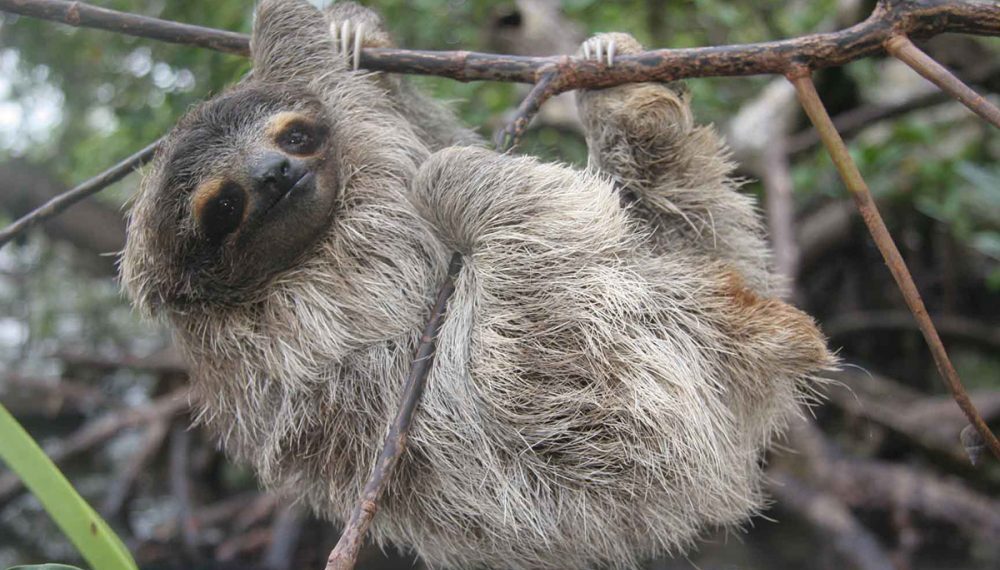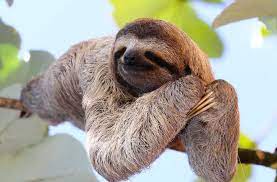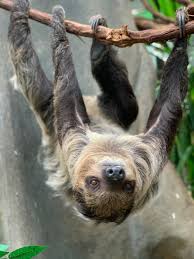Sloths, members of the order Pilosa and the suborder Folivora, are renowned for their tree-climbing abilities. The term “sloth” is often associated with slowness, and being called “slothful” implies laziness.
There are currently six living species of sloths, categorized into two genera: Bradypus and Choloepus. Bradypus has three toes on both the forelimbs and rear, while Choloepus has two toes on the forelimbs and three on the rear.
Scientific Classification
- Kingdom: Animalia
- Phylum: Chordata
- Class: Mammalia
- Superorder: Xenarthra
- Order: Pilosa
- Suborder: Folivora
- Family: Bradypodidae
- Genus: Bradypus/Choloepus
- Scientific Name: Choloepus hoffmani (Hoffman’s two-toed sloth)
Characteristics
- Length: 21 to 29 inches
- Weight: 10 to 13 pounds
- Venom/Poison: No
- Skin Type: Fur
- Habitat: Tropical rainforests
- Range: Americas
- Diet: Omnivore
- Life span: 25 to 40 years
- Gestation Period: 150 to 182 days
- Conservation status: Endangered
5 Interesting Facts About Sloths
- Slow Lifestyle: Sloths are famously slow animals, spending most of their time in trees eating and sleeping. Their slowness is an evolutionary adaptation that has allowed them to survive over millions of years.
- Surprising Strength: Despite their sluggish appearance, sloths are remarkably strong. In fact, they are three times stronger than humans. They can carry heavy objects with just one arm, showcasing their physical prowess.
- Meticulous Hygiene: Sloths have a unique bathroom behavior. They only defecate once a week, and during that time, they descend from the trees and dig a hole before relieving themselves. This behavior is thought to help maintain a cleaner environment.
- Expert Swimmers: Sloths are proficient swimmers, even though their land-based movements can be awkward. They use breaststrokes and their long limbs to propel themselves through the water. Swimming allows them to search for mates and new habitats.
- Limited Vision: Sloths have poor eyesight and are mostly active at night. They are completely color blind due to the absence of cone cells in their eyes, which limits their ability to see in bright daylight.
General Description

Sloths earned their name from the combination of “slow” and “th,” which accurately reflects their unhurried lifestyle. They have a low metabolism, low body temperature, and spend most of their time hanging in trees. There are six species, divided into two genera based on the number of toes and neck vertebrae.
Distribution and Habitat
Sloths inhabit the Americas, mainly South and Central America. They thrive in various forest types, including rainforests, mangroves, and cloud forests. These arboreal creatures are adapted for tree life, where they eat, sleep, mate, and raise their young.
Diet
Sloths have varied diets based on their species. Three-toed sloths are herbivores, primarily consuming fruits and leaves. Two-toed sloths, on the other hand, are omnivores, alternating between plants and small animals. Their slow digestion takes days to months.
Reproduction and Mating Process
Sloths have promiscuous mating behaviors. Two-toed sloths have no set mating time and can mate year-round. Three-toed sloths tend to mate during late summer and early fall. The mating process involves females signaling their readiness to mate, with some sexual selection and competition among males.
Predators and Threats
Sloths have predators such as snakes, jaguars, and large birds of prey. They defend themselves by swiping and using camouflage. Human activities pose threats, leading to habitat loss and endangering vulnerable species.

Behavior
Sloths are primarily solitary and nocturnal animals. They spend most of their time in trees, where they eat and sleep. They are excellent swimmers, utilizing breaststrokes to move through water. Sloths are active at night and sleep for up to 15 hours a day.
Male vs Female
Distinguishing between male and female sloths is challenging, as both genders look similar. DNA testing is often used for accurate identification. Sloths exhibit little sexual dimorphism, making visual distinction difficult.
Sloths are fascinating creatures with unique adaptations that have contributed to their survival for millions of years. Their slow, tree-dwelling lifestyle and camouflage strategies have allowed them to thrive in various environments, ensuring their continued presence in the future.
Conservation Status and Threats
Sloths face various threats that have led to different conservation statuses among species. Some are listed as “Least Concern,” while others, like the maned three-toed and pygmy three-toed sloths, are considered vulnerable and critically endangered. Habitat loss due to human activities, including deforestation, is a significant threat to their survival. Additionally, the illegal pet trade poses dangers to certain sloth species.

Human Interaction and Pet Trade
While sloths might seem docile, they are not suitable pets and should not be kept in captivity. Their unique needs and behaviors make it challenging to provide adequate care. In some cases, people may attempt to keep them as pets, but this is detrimental to the animals’ well-being and conservation efforts.
Future Outlook
Despite their slow nature, sloths have proven to be remarkably adapted to their environments. With more species categorized as “Least Concern,” there is hope for their continued existence. Ongoing conservation efforts, habitat preservation, and public education about the importance of these creatures in their ecosystems are essential to ensuring the survival of sloth populations.
In conclusion, sloths are fascinating and unique mammals that have captured our curiosity due to their slow-paced lifestyle, physical adaptations, and remarkable survival strategies. Their behavior, diet, and characteristics demonstrate their ability to thrive in diverse ecosystems, even as they face challenges from human activities. It is crucial to appreciate and protect these extraordinary creatures for the benefit of both their species and the health of our planet.
Research and Conservation Efforts
As more attention is drawn to the importance of conserving biodiversity, researchers and conservationists are working to better understand sloths and their ecosystems. Scientific studies help shed light on their behaviors, reproductive habits, and ecological roles, which in turn informs conservation strategies. Efforts are being made to protect and restore their natural habitats, raise awareness about the threats they face, and implement measures to mitigate human impact on their populations.
Role in Ecosystems
Sloths play crucial roles in their respective ecosystems. They contribute to seed dispersal and nutrient cycling through their consumption of fruits and leaves. Their slow movements and limited range prevent them from overgrazing on particular plant species, allowing for plant diversity to flourish. This highlights the intricate web of interactions that maintain the balance of the natural world.
Education and Awareness
Educating the public about sloths and their significance in the ecosystem is essential for their conservation. By fostering an understanding of their behavior, habitat needs, and vulnerabilities, we can encourage responsible practices and support efforts to protect their natural environments. Zoos, wildlife organizations, and educational programs play a crucial role in raising awareness about these fascinating creatures and inspiring action to safeguard their future.
Supporting Conservation
There are several ways individuals can contribute to sloth conservation. Supporting reputable wildlife organizations that focus on habitat preservation, research, and education is one effective approach. Donations to these organizations can directly fund efforts to protect sloths and their habitats. Additionally, advocating for policies that prioritize conservation and sustainable development can have a positive impact on sloth populations and biodiversity as a whole.
Conclusion
Sloths, with their unique characteristics, behaviors, and adaptations, offer a captivating window into the world of wildlife. While their slow movements might give the impression of vulnerability, they have managed to thrive in their environments for millions of years. Understanding and appreciating these remarkable creatures can lead to a deeper connection with nature and a commitment to their conservation. By working together to protect their habitats and raise awareness, we can ensure that sloths continue to be a part of the intricate tapestry of life on Earth for generations to come.C




















